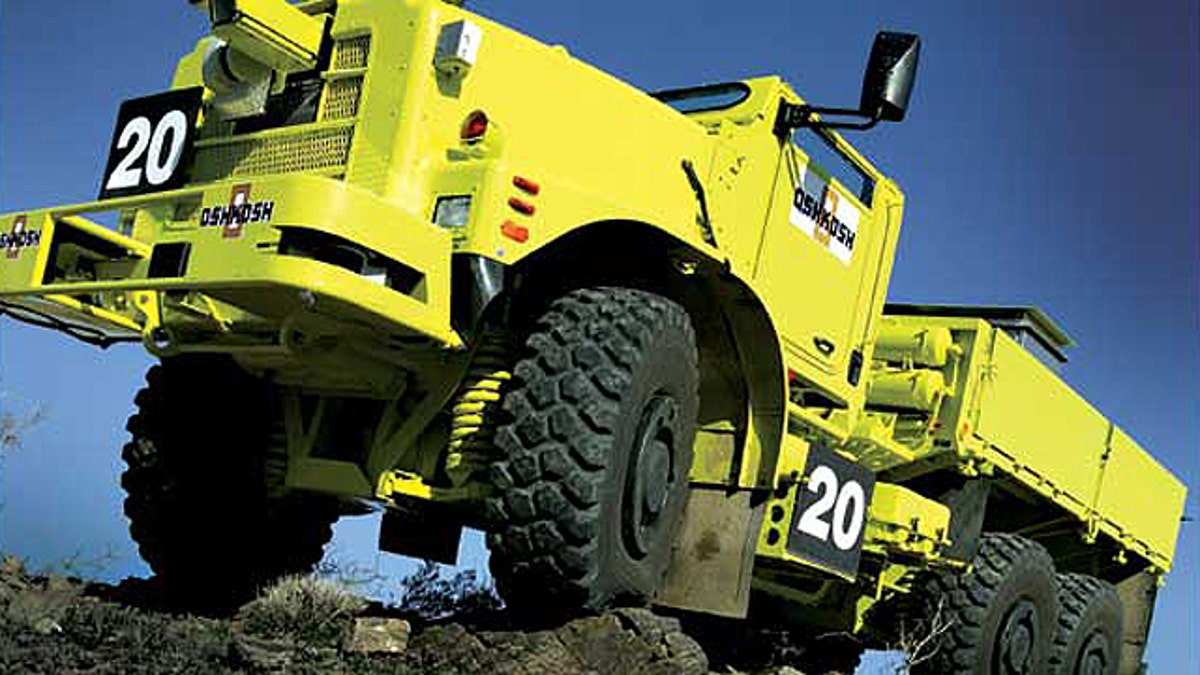
Oshkoshs self-driving, self-navigating TerraMax, designed to complete missions and keep U.S. soldiers out of harms way. (Oshkosh Corp.)
How is a weapons fair like a daycare?
Munchkins accompanied parents serving in the Army and contingents of school children -- including a platoon from the youth reporters at A Back Pack Journalist -- took to the show floor exploring the latest in defense technology at the annual Association of the United States Army (AUSA) meeting this week in Washington, D.C., a family friendly showcase of the latest military gear.
The kids had a blast, thanks to “rock” watch dogs, super-size remote control cars and an Optimus-Prime style robot trucks – three of the top items cool for both the kids and the war fighters alike.
Rock or Watchdog?
It looks like a rock, but it thinks like a vigilant sentry.
Pretend rocks -- also known as Northrop Grumman’s Scorpion II unattended target recognition systems -- are perfect as look outs both for the backyard tree house and for safeguarding a perimeter around the forward operating base (FOB). Providing their owner with 24/7 surveillance, these Scorpions are also useful on the offensive for covertly staking out targets.
The sentinels will sleep until an encroaching enemy triggers it: It integrates sensors for activity or movement, day and night vision, and seismic and magnetic activity. With its EO and IR sensors, the Scorpion II can detect and recognize at up to approximately 2,600 feet away day or night. And Scorpion II can send information out securely through wireless RF.
Handily its open system architecture means it can adapt to new sensors from most vendors as well. The advanced design means a lower operating power and longer battery life -- sentinel rocks have a mission life up to six months or even longer.
More than 900 Scorpion systems are already in the field. The portable, easy-to-deploy Scorpion II has halved the weight, size and cost of its predecessor.
A Transformers-style robotruck
While not yet at Optimus Prime level, the Marine Warfighter Lab in Quantico and the Oshkosh Corp. are making serious headway on a robotic truck.
Logistic convoys are frequently attacked and under IED threat, so it's critical to get soldiers out of the cabs of vehicles if possible. One objective of the U.S. Armed Forces is to have one-third of operational ground combat vehicles unmanned by 2015 and TerraMax demonstrates the goalposts have moved closer to that end.
Known as the TerraMax, this robotic truck is based on Oshkosh’s Medium Tactical Vehicle Replacement (MTVR) defense truck platform. Equipped with a military grade Global Navigation Satellite System (GNSS), it uses radar to avoid obstacles and very high definition LIDAR – Light Detection and Ranging-- to understand ground surfaces. Correctly interpreting standing water is always a big challenge for these robots; Oshkosh told War Games it has made excellent progress on that front.
The robotic truck can be manned, tele-operated and programmed to autonomously follow a route or a lead truck. If the lead vehicle in a convoy is attacked, it's easy for the operator to reprogram the truck to follow a new leader.
The TerraMax can be driven by an x-box-like console, and for the soldier managing the robotic convoy it is very similar to using a Blue Force Tracker. It can even set tire inflation, lock configuration, adjust thresholds and range of deviation in obstacle avoidance.
Raider II: a Speedy Robust Robotic Mule
Supersized remote-controlled vehicles are very cool. Robot ones are even cooler. The Raider II is both.
QinetiQ’s cutting-edge UGV Raider II, based on a chassis from Polaris Defense, is an automous mule powered by a 904cc, 24HP engine with a top speed of 35 mph. Operations up to 300 miles can be conducted on its nine-gallon tank that takes diesel often the preferred fuel in theatre. It can carry a 1,750 pound payload and tow a full ton. It can get through those narrow spaces, making this robomule a good choice for pushing and pulling mine rollers.
With a portable control unit, a solider can guide it from as far as a kilometer away. In autonomous mode, it can detect and avoid obstacles, navigate from waypoints and features very cool advanced "follow-me."
The stand out about Raider II is the autonomous security feature: sensors triggered by any approach. Once alerted, soldiers can use the various cameras and thermal sensors to work out whether it's just a curious local child or someone with malintent. An integrated speaker even lets the soldier communicate with the locals in these situations.
Raider II also features a multi-mount winch for self-recovery and helicopter lifting points. The cargo bed has two standard NATO litters and a medical kit, making it useful for not just resupply and reconnaissance but also MEDEVAC.
Surveillance rocks, thinking trucks and supersized remote controlled vehicles -- munchkin and war fighter crowd-pleasers alike.
Ballet dancer turned defense specialist Allison Barrie has travelled around the world covering the military, terrorism, weapons advancements and life on the front line. You can reach her at wargames@foxnews.com or follow her on Twitter @Allison_Barrie.
